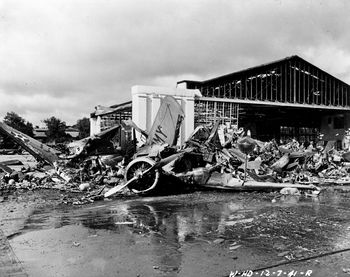Wheeler Army Airfield
|
Became a separate permanent military post on 31 Aug 1939 as Wheeler Army Air Base. Renamed Wheeler Air Force Base on 26 Mar 1948. Place in caretaker status on 21 Nov 1949 and reactivated 24 Feb 1952. Transferred back to the Army and renamed Wheeler Army Airfield on 1 Nov 1991. Active U.S. Army Airfield. Also known as Wheeler Field (general usage), Wheeler Army Air Base and Wheeler Air Force Base. Pre World War IIEstablished 6 Feb 1922 by 1st Lt. William T. Agee and a detachment of 20 men from Luke Field on Ford Island. By 30 Jun 1923 hangers and storage tanks were in place. In the 1930s permanent construction began at Wheeler Field and by 1940, the base had become the primary base for fighter aircraft in the Hawaiian Islands. World War II (1941-1945)Wheeler Army Airfield was one of the first targets of the Japanese attack on 7 Dec 1941. The Japanese destroyed most of the planes on the ground, but 12 pilots assigned to Wheeler succeeded in getting their fighter aircraft off the ground and engaged the enemy. These fighters shot down nine Japanese aircraft. Casualties at Wheeler totaled 37 killed, 6 missing and 53 wounded.  Wheeler continued to served during World War II as part of the US Army Air Forces.
Cold War (1947-1991)Wheeler was briefly deactivated after the war and the newly established United States Air Force took over the assets of the Army Air Forces. Wheeler was reactivated in the buildup to the Korean War as Wheeler Air Force Base and continued during the Vietnam War and for the remainder of the Cold War era. Air DefenseIn July 1965 the Hawaii Air National Guard transferred some 220 members of the 169th AC&W Squadron from Koko Head to Wheeler AFB in support of the Kaala Air Force Station air defense radar site. Also operated by active Hawaii Air National Guard members of the 169th AC&W Squadron was the JSS System Regional Operations Control Center (JSS ROCC). The ROCC was established in 1984 on Wheeler Air Force Base to assume control of Hawaiian airspace in conjunction with the FAA. Currently known as the Regional Air Operations Center (RAOC). Inputs to the command center include radar data from an FPS-117 minimally attended radar site at Kokee Air Force Station (H-02), ARSR-4 Radar at Kaala Air Force Station (H-01) and other sensors. Data is exchanged with the North American Aerospace Defense Command (NORAD) at Peterson Air Force Base, Colorado, the United States Northern Command (USNORTHCOM) and the Federal Aviation Administration (FAA). Return to U.S. Army ControlAt the end of the cold war era Wheeler Air Force Base was transferred back to the Army and renamed Wheeler Army Airfield on 1 Nov 1991.
Current StatusActive military installation. Access may be restricted. The installation has a National Historic Landmark District in association with the attack on 7 December 1941. The 1941 Flightline, hangars and barracks survive today. The Regional Air Operations Center (RAOC) remains operational, still operated by active Hawaii Air National Guard members.
See Also:
Sources:
Links: Visited: No
|


